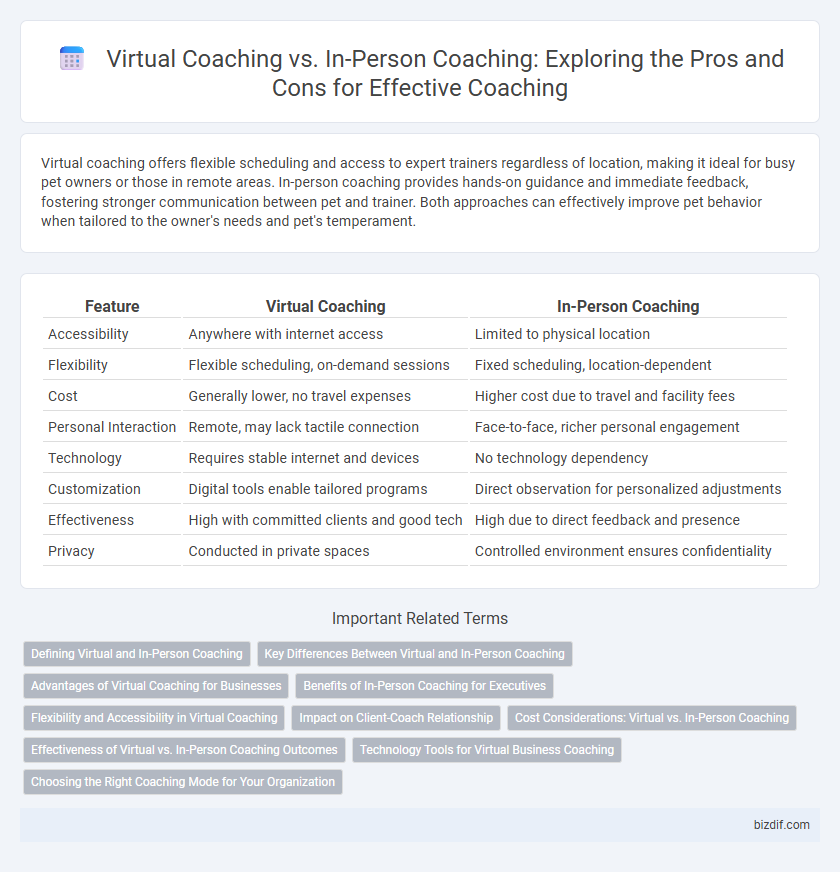Virtual coaching offers flexible scheduling and access to expert trainers regardless of location, making it ideal for busy pet owners or those in remote areas. In-person coaching provides hands-on guidance and immediate feedback, fostering stronger communication between pet and trainer. Both approaches can effectively improve pet behavior when tailored to the owner's needs and pet's temperament.
Table of Comparison
| Feature | Virtual Coaching | In-Person Coaching |
|---|---|---|
| Accessibility | Anywhere with internet access | Limited to physical location |
| Flexibility | Flexible scheduling, on-demand sessions | Fixed scheduling, location-dependent |
| Cost | Generally lower, no travel expenses | Higher cost due to travel and facility fees |
| Personal Interaction | Remote, may lack tactile connection | Face-to-face, richer personal engagement |
| Technology | Requires stable internet and devices | No technology dependency |
| Customization | Digital tools enable tailored programs | Direct observation for personalized adjustments |
| Effectiveness | High with committed clients and good tech | High due to direct feedback and presence |
| Privacy | Conducted in private spaces | Controlled environment ensures confidentiality |
Defining Virtual and In-Person Coaching
Virtual coaching involves providing guidance and support through digital platforms, enabling remote communication via video calls, phone, or messaging. In-person coaching takes place face-to-face, allowing for direct interaction and immediate feedback within a shared physical environment. Both methods aim to enhance personal or professional growth but differ primarily in their mode of delivery and engagement dynamics.
Key Differences Between Virtual and In-Person Coaching
Virtual coaching offers flexibility and accessibility by enabling sessions from any location with internet access, while in-person coaching provides more direct personal interaction and non-verbal communication cues. Technological tools in virtual coaching facilitate resource sharing and session recording, whereas in-person coaching often allows for more immersive and dynamic engagement through physical presence. Both methods require tailored approaches to build trust and rapport, but the effectiveness depends on individual learning styles and coaching goals.
Advantages of Virtual Coaching for Businesses
Virtual coaching offers businesses increased flexibility and cost savings by eliminating travel expenses and allowing sessions to be scheduled across different time zones. It enables access to a broader pool of expert coaches, enhancing talent development and specialized skill acquisition. Enhanced digital tools and platforms provide businesses with detailed analytics and progress tracking, optimizing the coaching outcomes and improving employee performance.
Benefits of In-Person Coaching for Executives
In-person coaching offers executives personalized interaction, allowing coaches to read non-verbal cues and tailor feedback more effectively. The face-to-face environment fosters deeper trust and stronger rapport, enhancing communication and collaboration. Executives benefit from immediate, focused attention in a distraction-free setting that supports comprehensive skill development and accountability.
Flexibility and Accessibility in Virtual Coaching
Virtual coaching offers unmatched flexibility by allowing clients to schedule sessions from any location, removing geographic and time constraints commonly associated with in-person coaching. This accessibility enables individuals with busy lifestyles or mobility challenges to engage more consistently in coaching programs. Digital platforms support seamless communication and resource sharing, enhancing the overall coaching experience beyond traditional face-to-face interactions.
Impact on Client-Coach Relationship
Virtual coaching leverages digital platforms to maintain consistent communication, enabling flexible scheduling and broader accessibility that strengthens client engagement. In-person coaching facilitates deeper emotional connection and non-verbal cue recognition, enhancing trust and rapport between client and coach. Research indicates a hybrid approach may optimize the client-coach relationship by combining convenience with personal interaction, leading to improved coaching outcomes.
Cost Considerations: Virtual vs. In-Person Coaching
Virtual coaching generally offers more cost-effective solutions due to reduced expenses in travel, facility rental, and flexible scheduling options that optimize time management. In-person coaching often entails higher fees reflecting venue costs, commuting, and potential time lost, which can affect overall affordability for clients. Budget-conscious individuals and organizations increasingly prefer virtual coaching to maximize value while maintaining access to quality guidance.
Effectiveness of Virtual vs. In-Person Coaching Outcomes
Virtual coaching demonstrates comparable effectiveness to in-person coaching by utilizing digital tools that enhance accessibility and allow for flexible scheduling, which promotes consistent progress tracking. Research indicates that client satisfaction and goal achievement rates in virtual coaching closely rival those of face-to-face sessions, especially when platforms incorporate video, real-time feedback, and personalized content. Despite the lack of physical presence, virtual coaching's ability to leverage data analytics and tailored communication often results in equally impactful outcomes as traditional methods.
Technology Tools for Virtual Business Coaching
Virtual coaching leverages advanced technology tools such as video conferencing platforms, collaboration software, and digital scheduling systems to enhance client engagement and streamline session management. Interactive features like screen sharing, real-time feedback, and cloud-based resource libraries enable personalized and flexible coaching experiences. These tools provide scalability and accessibility, making virtual business coaching a practical alternative to traditional in-person sessions.
Choosing the Right Coaching Mode for Your Organization
Virtual coaching offers flexibility and accessibility, enabling organizations to connect with experts worldwide without geographical constraints. In-person coaching fosters deeper personal connections and immediate feedback, which can enhance relationship-building and trust within teams. An organization should evaluate its goals, team dynamics, and technology infrastructure to select the coaching mode that maximizes engagement and drives impactful outcomes.
Virtual Coaching vs In-Person Coaching Infographic

 bizdif.com
bizdif.com